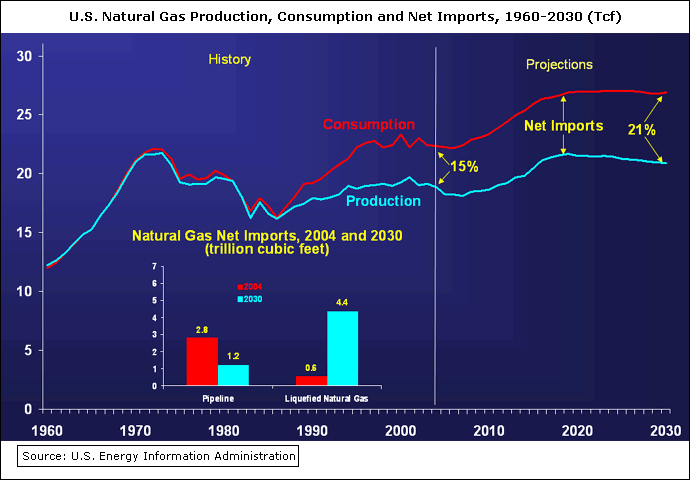One of the biggest challenges facing energy policymakers and natural gas industry officials in the northeastern United States is securing enough gas supply to meet growing demand from both LDCs and the power generation sector, FERC Commissioner Suedeen Kelly said Dec. 8 during a panel discussion in New York City sponsored by the Center for Liquefied Natural Gas.
"Even if we increased the pipeline capacity, we're really talking about the supply," she said. "It's also no secret that if last winter had been a cold winter, there's a very high likelihood that there would have to have been rationing of gas in the Northeast. It was a very precarious situation." The Northeast, along with the entire nation, faced an unstable gas supply picture heading into the winter of 2005-2006 due to significant production damage caused by Hurricanes Katrina and Rita.
Kelly said it is unclear whether the public in the Northeast "understands how tight the gas situation really is. In the winter of 2004, we came very, very close to having to ration gas. There was a situation where it was a question of whether the gas should go into the heating or the electricity."
Bill Cooper, executive director of the Center for LNG, argued that the supply-and-demand balance in the Northeast is  growing more unstable. "And if we don't start addressing it, there's going to be a lot of people who are going to suffer the consequences in the form of higher prices, or even worse, shortage of supply," Cooper said. The Center for LNG is a coalition of more than 60 LNG producers, shippers, terminal operators and developers, energy trade associations and gas consumers.
growing more unstable. "And if we don't start addressing it, there's going to be a lot of people who are going to suffer the consequences in the form of higher prices, or even worse, shortage of supply," Cooper said. The Center for LNG is a coalition of more than 60 LNG producers, shippers, terminal operators and developers, energy trade associations and gas consumers.
Another panel member, KeySpan Corp. Executive Vice President David Manning, noted that when citygate prices spiked to $45 in New York and $75 in Boston during an extreme cold snap in January 2005, KeySpan "had to take down over 500 customers because we couldn't get supply. … And there has been no enhanced infrastructure since that day."
Forecasts continue to show that the United States will need to find new sources of supply to meet growing demand. Domestic producers are struggling to maintain their current production rates, and pipeline imports from Canada are expected to remain flat or decline slightly in the coming years. "By 2025, LNG will need to fill the gap," Kelly said.
Attempting to get LNG import terminals located near market areas would improve deliverability and decrease the cost of gas, she noted. "By having all of the gas come in through the Gulf region, you do face the need of enhancing the pipeline's takeaway capacity out of the area," she said. "It can be done but adds to the cost and to the time involved in getting it out of the Gulf. It also increases the security issues by putting all of our production in the Gulf area."
Manning agreed that regasified LNG "has to go where the consumption is." However, one of the challenges facing KeySpan and other companies in the Northeast is that "you can't get across the Hudson River," Manning said, referring to intense opposition that developers face when seeking to build gas transportation systems across the river.
"We cannot get additional gas from the Gulf across the Hudson River," he said. "Millennium Pipeline [Co. LP] has had to reapply and modify its route to stay on the wrong side of the river."
Bringing gas up from the Gulf Coast "doesn't really do it necessarily for the Northeast," Manning said. "That's why there's such a tremendous effort to get new LNG supplies into the Northeast on the market side of the Hudson River," he added.
The panelists also agreed that Canadian LNG import facilities, while an important component of the U.S. Northeast supply portfolio, will not satisfy the region's long-term needs. "We are lucky that Irving Oil [Ltd.]'s Canaport facility is under construction because it will take the pressure off in the immediate short term into New England once that gets online," Kelly said. The Canaport facility is  scheduled to begin operations in late 2008, with an initial sendout capacity of 1 Bcf/d that will be expandable to 2 Bcf/d when the market is ready for additional gas supplies.
scheduled to begin operations in late 2008, with an initial sendout capacity of 1 Bcf/d that will be expandable to 2 Bcf/d when the market is ready for additional gas supplies.
The Canaport facility is "a good start, but that's not going to solve the problem long term," she said.
"As we go forward looking at demand in the New England area over the next 20 years, a 1 Bcf facility will not be enough to get the job done," Cooper said. "We're going to have to have more."


